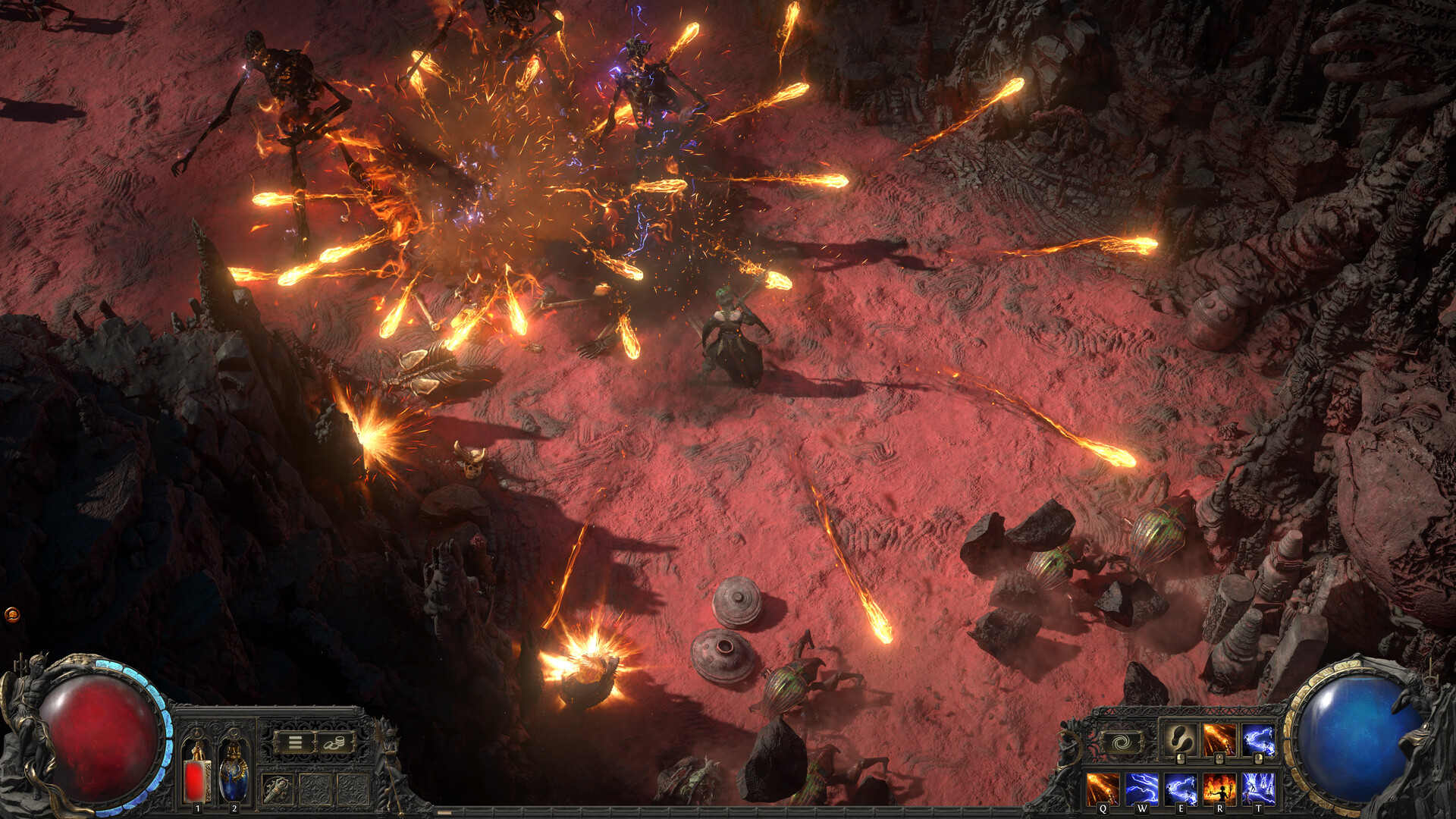
Path of Exile 2 is now available for early access on Xbox Series X/S, PS5, and PC. That is, for those who somehow managed to get in after the long queues, crowded servers (which have faced issues since the title went live), and whatnot. To say that it’s extremely popular would be an understatement, one that the 459,263 peak concurrent player count on Steam doesn’t fully convey because there are also those logging in through the standalone launcher.
Game director Jonathan Roberts revealed before release that they passed one million early access redemptions. While this was good news, especially since sales continued to go up, the development team had only prepared for one million players. It didn’t expect to require more server capacity and began ordering additional database shards and scaling things up.
“We don’t know what our backend services are going to be able to handle as we go above a million users,” he said. Famous last words, as Grinding Gear Games is still struggling to accommodate the swarm of launch players. Its last updates on Twitter indicated it was letting players in through batches and monitoring the backend to ensure it isn’t overloaded. The official website has been restored after going down for several hours, thus preventing many from claiming their Steam keys.
The sheer overwhelming demand is to be expected. After all, Path of Exile has been around since 2013 (not including the alpha and closed beta) and become one of the most beloved free-to-play titles in history. It would trounce the likes of Diablo 4 with its depth, wealth of content, and innovation. Perhaps the only times that Path of Exile has ever faltered in popularity is by becoming its worst enemy, delivering underwhelming updates or massive changes that weren’t received well.
Path of Exile 2 generated excitement from the first announcement trailer back in 2019, and the hype has only increased a hundred-fold ever since. The sheer number of delays also exacerbated the mania of players who wanted to get their hands on it. What makes the game so addictive for so many players? Why is it attracting so much attention for early access, even if it is the sequel to an incredible action RPG?
The combat is a good place to start because it bleeds into everything else. Path of Exile 1’s gameplay loop accommodates an almost endless number of different playstyles and builds. The itemization is complex, and whether it’s through crafting knowledge, luck, or hitting it big with currency, you could create some bonkers gear to tear through the end-game.
By comparison, Path of Exile 2 is newer yet a return to the simpler days. Movement is weightier and more realistic, while the hits are more impactful and visceral. A new dodge roll allows for more effectively avoiding attacks, with much of the incoming damage feeling more telegraphed. It feels slower-paced, but that’s an illusion – enemies soon start swarming faster, pushing each other to get to you.
Your first boss remains just that – the evil hag launching cold attacks and sending emaciated wolves at you is your new biggest threat. What else awaits in the woods? And more importantly, what kinds of rewards will they give? That danger, that thrill, slowly becomes infectious as you grind through enemies, equipping whatever noteworthy gear and weapons may drop while leveling up and slowly improving your character with either more survivability or damage.
Though you’ll start with only a handful of Skill Gems – which not only require a specific character level and stats but depend on the Uncut Gems in question dropping – there’s still plenty of room for experimentation. When I opted for the Sorceress, it was all about Spark and Flame Wall – the former covered a relatively decent area but remained inaccurate. The latter damaged enemies stepping through and augmented Spark with extra fire damage.
As my level increased, I started experimenting with Orb of Storms and Frostbolt, weaving in different elements, picking up passives that could leverage all three at once, and attempting to pile on the elemental damage from the get-go. However, there were all the Support Gems, which augmented Skills in different ways. A higher cooldown for Flame Wall in exchange for more damage; shattering frozen enemies to create a chilling Vortex against others; extending the duration of Orb of Storms to ensure more lightning chains – we’re still in relatively simple territory, but things were quickly becoming more complicated.
Easily swapping out Skill and Support Gems is incredible alongside resetting your Passives with Gold, which also helps with the experimentation. If you’re not feeling something or want to go in a completely different direction, it’s easy to swap from the get-go. Even in the late-to-end game, swapping builds is far less punishing than in Path of Exile 1, as long as you have the relevant gear, especially because Skill Gems don’t require additional leveling. Engrave a high-level Skill Gem and you get the better version of that Skill, no grinding required.
Combat becomes more nuanced as your build is defined, and sure enough, you’ll face enemies with a wider range of abilities and dangerous modifiers. Yet that desire to keep pushing forward, to reach the next objective, is unmatched. It isn’t just the rewards, from XP to obtain more power from the Passive Tree to currency for augmenting your gear, but unleashing your newfound capabilities on enemies. Soon enough, entire screens start shattering from lightning storms, comets, and fiery rains while you construct frozen walls, curse them, and slow them. Eventually, you’ll find things more challenging, and it’s back to the drawing board to make some adjustments.
As worthwhile as your gear and weapons may seem because of how they fit your requirements, it quickly becomes apparent that higher-level loot is better in the long run because of the higher stat rolls. Since entering Cruelty Difficulty will stifle your Resistances, reducing them by as much as 50 percent, you need to change things to survive. You can’t deal damage if you’re dead, after all. It’s yet another thing you’ll pursue near-endlessly, even as things become more challenging in the end-game.
And if the campaign didn’t keep players addicted throughout, they have no hope for escape in the end game. The Atlas of Worlds is tailor-made to make you go, “Just one more map.” Waystones are necessary to access nodes and enter the maps to slay enemies, but you’re also on a path towards specific objectives like the Lost Towers. While you could prioritize them, there’s also the desire to check out nodes with bosses or additional systems like Delirium and Ritual which can confer specific benefits to your equipment or provide more currency and gear.
If you die in those maps, those modifiers are gone, and it’s try, try again on the next node. “Just one more map,” you’ll once again say. Of course, Waystones can also have modifiers, increasing monster difficulty in different ways, yet upping the quantity of dropped items (including more Waystones). By the time you clear out different tiers and earn points to allocate to your Atlas Tree for further tuning your end-game experience, you’re probably already over 50 hours deep. It’s already too late, so the only thing left to do is keep going.
All of this is just for one class. If you get bored or want a change of pace, there are five other compelling options to choose from, each fun in its own way, and thus the cycle begins again. Such is the Path of Exile experience, but with Path of Exile 2, the addiction feels better than ever.
Note: The views expressed in this article are those of the author and do not necessarily represent the views of, and should not be attributed to, GamingBolt as an organization.
















